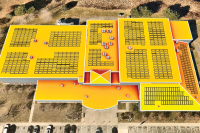Landslide mapping continues, albeit on a smaller scale
 To Jenifer Bauer, the conditions couldn’t be better for a hike. It’s cold and soggy. There’s no leaves left, nothing green at all on the forest floor save the rhododendrons and mountain laurels. Even the views are dreary and gray, leaving nothing better to look at than the ground beneath her feet.
To Jenifer Bauer, the conditions couldn’t be better for a hike. It’s cold and soggy. There’s no leaves left, nothing green at all on the forest floor save the rhododendrons and mountain laurels. Even the views are dreary and gray, leaving nothing better to look at than the ground beneath her feet.
But that’s what interests Bauer anyway.
A geologist who specializes in landslide sleuthing, Bauer will spend the winter months tromping through the Wayehutta Creek watershed of Jackson County, looking for the telltale signs of mudslides and slurries that came crashing down decades, centuries or even millenniums ago.
Landslides aren’t like lightening. They can — and do — strike the same place twice.
Figuring out where past slides occurred is the best indicator of where future ones might happen. That’s the premise of the landslide hazard mapping that Bauer’s firm, Appalachian Landslide Consulting, is all about.
Related Items
The firm has been hired to create maps of landslide prone slopes in parts of Haywood and Jackson counties.
But the work is a shadow of what the project once was: a bold mission to map landslide hot zones in every mountain county. State lawmakers axed the project in 2011, however, laying off a team of five state geologists mid-stride. They had mapped high-risk landslide zones in four counties since the project’s inception in 2006.
Now the work is continuing on a smaller scaled with private grant funding in the two mountain counties.
Macon County was among those completed, but work in Jackson County had barely begun and Haywood hadn’t been started on yet.
The landslide mapping work was deemed too costly, but it was also disparaged by some in the real estate and building industry as a threat.
“It was becoming political in terms of, ‘Holy cow, someone thinks they have beautiful mountainside property and there is a landslide hazard suddenly knocking,’” said Lynn Sprague, the director of the Southwestern N.C. Resources Conservation and Development Council.
But there was a groundswell of support to see the work continue — not just among environmental types but also emergency responders, land surveyors, county commissioners, and even some in the home building industry.
So Bauer and another geologist from the state’s laid off landslide mapping team started their own firm and have picked up the torch — with the backing of privately raised grant funding.
The landslide hazard surveys take Bauer tramping over a lot of private property, but the team always get permission first.
“We knock on a lot of doors,” Bauer said. “We usually only have two people who won’t let us come on.”
There’s a mighty big carrot for landowners to agree, details of which are spelled out in a pamphlet that Bauer takes with her.
“This inventory will identify currently unstable areas that may be more likely to fail during heavy rain …. These will show where, during heavy rain events, landslides might start as well as the areas they might affect,” the pamphlet explains.
Mapping landslide hazard zones will alert people who live in these areas to take heed when there’s heavy, prolonged bouts of rains. Jackson County tallied more than five dozen landslides during a week of heavy rain last winter.
“We hope to increase awareness of landslides in the county so they can be better prepared for when the next heavy rain event comes,” Bauer said.
It will also give emergency responders a better idea of what they might be facing when responding to a landslide report, or even knowing where one is prone to hit, Sprague said.
“When they get called in, rocks are moving, trees are moving. Should they go over to that house?” Sprague said. “They need to know that if a road is undercut and they are doing an evacuation across it that it is not undercut to the point it will collapse.”
A slippery slope
The landslide mapping work in Jackson County has the endorsement of the Jackson County planning board.
The support is symbolic — particularly amid a roll back of steep slope building rules in Jackson County. The planning board has nearly finished a cover-to-cover rewrite aimed at loosening constraints on mountainside construction.
The changes would allow denser development, more tree clearing, more intensive grading and bigger footprints of disturbance than the current rules. The changes call for less rigorous geotechnical, soil and environmental impact studies. And the changes would also up the threshold for when steep slope rules kick in — the rules will only apply to the steepest slopes and no longer the moderately steep ones.
The planning board is nearly finished with the rewrites, which have been in the works for more than a year. The changes will ultimately go to county commissioners for a final decision this spring.
At first blush, it’s seems incongruous that the planning board would support landslide mapping on one hand yet push for weaker regulations when it comes to steep slope construction.
But in fact, it’s a testament to what landslide mapping advocates have been saying all along: landslide mapping simply makes sense.
“[County planning board members] stated consistently as we looked at the steep slope ordinance that they would like the information to assist them and to use as a planning tool,” said Jackson County Planner Gerald Green.
Despite claims by its supporters that landslide mapping is just handy information to have, some in the development and real estate industry have been skeptical. They fear areas flagged as “landslide prone” may come under restrictive building regulations or even be declared off limits. At the least, it could depress demand among potential buyers.
Landslide mapping advocates contend they have no ulterior motive to limit or restrict development on steep slopes. Instead, the goal is to make mountainside construction more compatible with the natural landscape and geography.
“We saw it as another bit of information to help developers make wise choices,” said Eric Romaniszyn, director of Haywood Waterways Association, one of the primary advocates for the landslide mapping in Haywood. “There are a lot of different solutions out there, but it is just trying to get folks to think about it and not do things the way they always have.”
When the enthusiasm for mountainside homes took off the 1990s, some developers buying up raw land for subdivisions plunked down house sites somewhat indiscriminately, with little forethought in how easy or hard it would be to actually carve out a building pad on any given lot.
“We want them to consider soils, slopes, streams, bedrock outcroppings, all the natural resources that go with any site, and consider them all when making choices of where to put a home site,” Romaniszyn said.
The landslide hazard maps can clue builders in when a little more diligence is called for, Bauer agreed.
“They should be used to trigger a site specific investigation,” Bauer said of the maps. “Use them as a tool to say, ‘OK maybe I should hire a geotechnical engineer or geologist to designs walls on this specific portion of my property.’”
Granted, a wall won’t stop a major landslide. But a properly built retaining wall guards against a landslide happening in the first place.
The majority of landslides originate on slopes that have been cleared, altered or excavated in some way, Bauer said.
“It takes much less rain to destabilize poorly constructed slopes,” Bauer said.
Knowing a slope is in a landslide hazard zone could influence the builder to take precautions on an individual level, Bauer said.
How — or even whether — communities choose to use the information is up to them.
For now, the landslide mapping work in Jackson is only tackling the Wayehutta Creek watershed, the mountainside that flanks Cullowhee to the east. Only $10,000 in grant funding has been secured so far in Jackson. It is a drop in the bucket compared to the price tag of mapping the entire county.
The Haywood model
The landslide mapping initiated this year in Jackson County is following in the footsteps of a similar effort in Haywood that began a year earlier.
In Haywood County, the work has been much more extensive thanks to $125,000 in private grant funding amassed by a coalition of environmental nonprofits.
Haywood has seen a rash of landslides in recent years. Several homes have been destroyed or destabilized. Dozens of private roads in subdivisions have washed out, leading to big repair bills for homeowners associations.
This unfortunate reality made the landslide mapping project in Haywood an easy sell, garnering relatively broad support.
The grant funding raised in Haywood was enough to map the greater Waynesville and Maggie Valley area plus Jonathan Creek.
Bauer said the price tag might seem steep, but not when compared to the millions in property damage to homes and roads and property landslides have caused in the region.
“The average home cost in North Carolina is something like $250,000. If we can save one home then that makes it worth the price of mapping the entire county,” Bauer said.
Advocates of the landslide mapping project encountered an unexpected hitch, however. There needed to be a project manager, an agency or entity willing to coordinate and “own” the project at the local level.
While county leaders supported the work, they didn’t want to be the ones to actually sanction it. The landslide maps turned into a bit of a hot potato.
Romaniszyn said it would defeat the purpose of sharing landslide hazard information with the public if the maps are sequestered or hidden in a hard to find place.
The Southwestern N.C. Resources Conservation and Development Council stepped up to the plate as a central repository for the maps.
“We feel like we can be neutral holders of the information. It is just like going to a public library, or just like an academic institution,” said Lynn Sprague, the director of the RC&D Council, which was formally a federal entity but now operates as a nonprofit.
Still, when the maps for Haywood are completed in the spring, it’s not clear how they will be publicized.
“We are working on figuring out the best way to distribute this information and make it available for use,” Bauer said.









